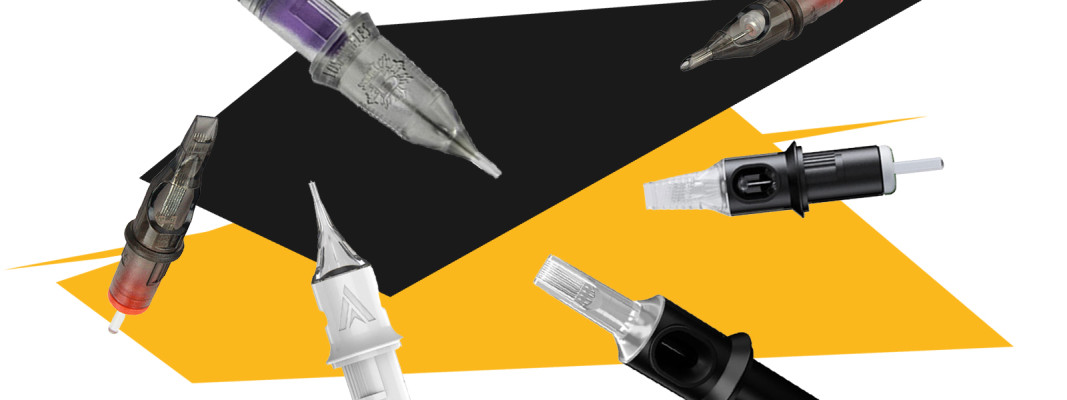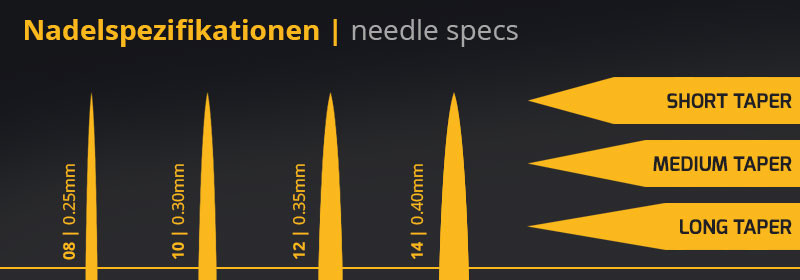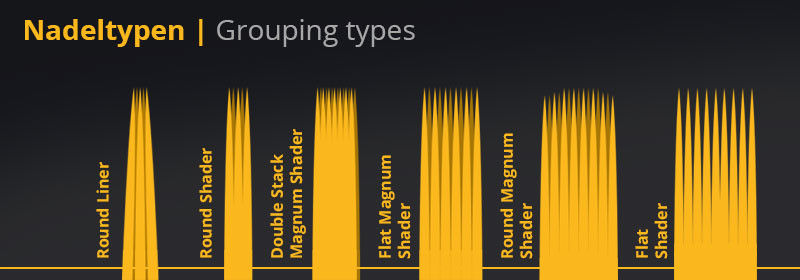Small guide for tattoo needles

There are now many different types and sizes of needles on the market. It's not easy to keep track of them all! We help you to bring light into the darkness and show you the differences between the various needles.
What are the needle point shapes?
All needle modules presented here are suitable for both rotary and bobbin machines.
In technical terminology, the needle tips are called tapers. Depending on the application and style, one or the other needles are more or less suitable. If you are not yet familiar with the abbreviations ST, MT, LT, XTL and BP, we can reassure you. The abbreviations are simply the designation of the length and nature of the needle tip.
- ST = Short Taper
the needles are used as area needles, for example for filling large areas
-
MT = Medium Taper (medium length tip)
suitable for thicker contours and for filling colored areas -
LT = Long Taper (very long tip)
all-rounder, ideal for contours and shades - XTL = Extrem Long Taper (very long tip)
mainly intended for contours -
BP = Bug Pin (finest taper type)
roughened surface transports more color into the skin. Suitable for line work

What types of tattoo needles are there and what are they used for?
Round Liner
Let's start with the Round Liner. As the name suggests, they are excellent for drawing lines. The needles are arranged in a circle and soldered. They run cone-shaped to each other at the tip, making them perfect for outlines. Due to the arrangement and nature of the needle, only a small amount of ink is absorbed and held for as long as possible. Depending on the number and thickness of the needle, the thickness of the lines varies. The fewer the needles and the thinner the tip, the finer and more filigree the lines will be.
These tattoo needles are very similar to the liner needles, but there is one serious difference. The Round Shader needles have a longer solder-free area. This means that the tips of the individual needles run straight and are further apart. This means that a larger bare area is visible, making the needles more flexible and allowing them to spring back when pierced. Since Round Shader needles are so-called one-off liners, they are arranged as round as possible so that a cavity can form in the middle. More ink is absorbed there, which ultimately provides more room for flow. Round shader needles are largely used for simple shading and for filling color.
The Flat Shader needles are lined up next to each other on one level. Usually 5-13 needles are soldered in a straight line. The color pickup is slightly less than with the round shaders, but you can still use them to tackle larger shades. Shading produces a lighter result than Round Liner needles, because they only pass through the skin once. In contrast, the needles are passed through the epidermis one after the other during lining, which results in extremely dark lines.
Let's move on to the most popular variant for shading, magnum shaders.
The tattoo needles of this type are spread and form two rows at the tip. The individual needles stand far apart and thus absorb a lot of ink. Thus, the ink can be worked into the skin quite easily. The color pigments distribute themselves optimally in the skin. This makes the Magnum Shader needles ideal for filling large areas.
These needles are also called soft edge needles because they allow extremely soft transitions when shading. The structure of the needles is the same as that of the Magnum Shaders, except that the needles are arranged in a curve. This does not necessarily make the application easier for beginners, but for experienced tattoo artists the even distribution of the color in the skin is a great advantage.

Which needle size is the right one for my purposes?
As already mentioned, the diameter of the needles also plays a decisive role in finding the right needle for your style. We present you the four most common strengths.
-
#8 = 0,25 mm
favors a slower ink flow for particularly detailed and precise work, but is also mor sensitive -
#10 = 0,30 mm
most popular thickness, as an even ink flow is possible for any application
-
#12 = 0,35 mm
is ideal for larger lines and also for filling areas - #13 = 0,40 mm
is mainly used for large-area tattoos, for example on the back
What number of needles should I choose?
The line is correspondingly thicker with a higher number of needles. Usually, the number of needles is given after the number for the thickness of the needle. Thus, a round liner needle with gauge #10 and a number of seven needles would have the designation 1007 RL.
But if you're not quite sure which tattoo needles suit you and your style best, it's a good idea to do a few test runs beforehand. Just order a few different needle types and a practice skin and off you go.

 German
German Dutch
Dutch